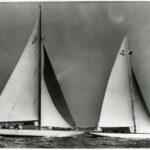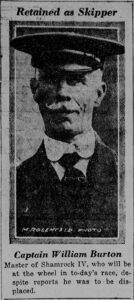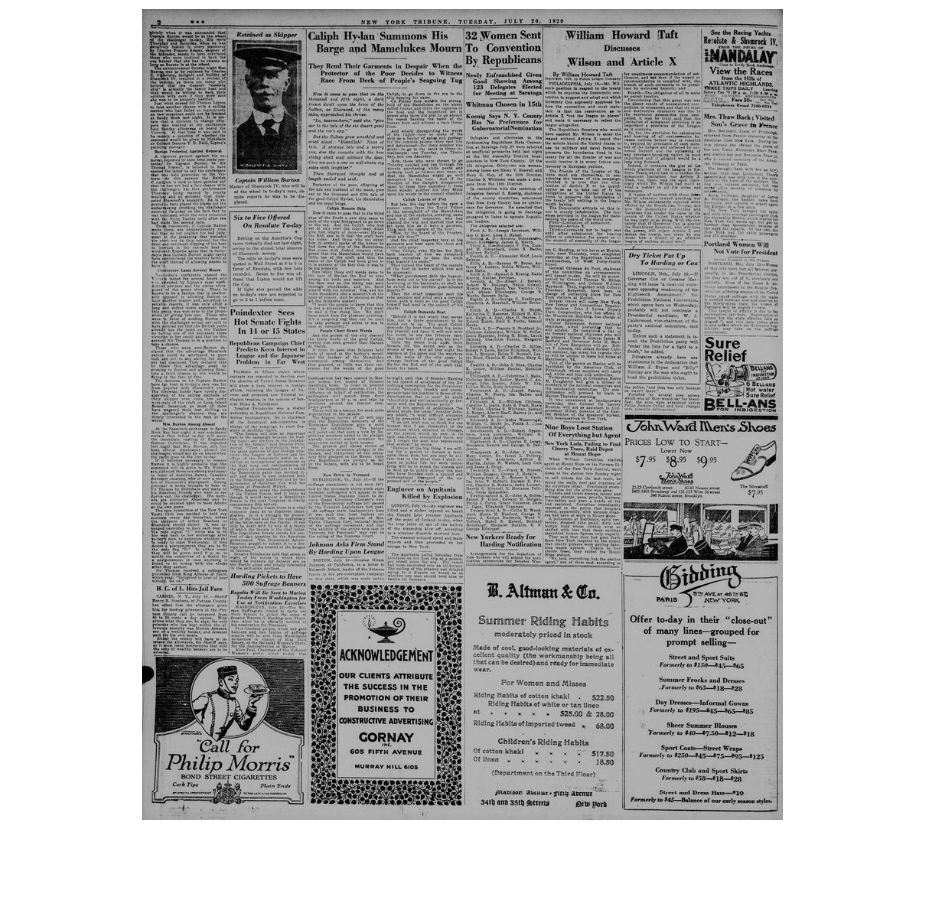Sir William Burton (1864-1942) had sailed in more than 1000 boats in British waters.
For twenty-five years, yachting was his favorite sport, but instead of making a game of yachting, he made it a serious study just as much as his business.
He was one of those men who did never stay at “the old ways of doing things” for long. He would enter everything with heart, soul, and great passion.
Of the 1,000 or more races that he has sailed in twenty-five years, 618 were on his own yachts, he won with these 235 first prizes and 140 others, making a total of impressing 375 victorious awards.
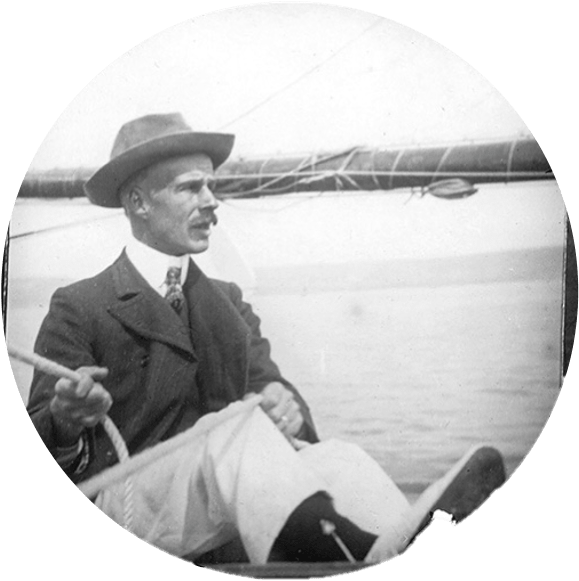
Mr Burton
-and his Yachts
Among the yachts, Mr. Burton has owned are the BRITOMART, VANITY, and LUCIDA. He was a dominating figure in the 12-metre class. Sir William Burton was figured prominently in all discussions in England, which have had to do with changes in the rules. He was one of the Vice Presidents of the Yacht Racing Association of Great Britain, and like most sailors, he started his yachting experience when he was but a youngster.
Burton went into the 12-metre class in 1924 by ordering a design, named NORESKA, from the designer; Johan Anker, Norway. In 1927 he had his next 12-metre designed and built, -the IYRUNA. This time by William Fife III (William Fife was the third generation of a family of Scottish yacht designers), along with Noreska, IYRUNA became the fastest of the six 12-metres that were sailing in the UK in those days.
Three years later, in 1930, he also had a 122-foot motor yacht built as a “tender”, the Caletta, for his racing exploits.
In 1934, Burton became president of the International Yacht Racing Union (now ISAF) and ordered his third 12-metre with Alfred Mylne; the MARINA. Marina was named after the charming young wife of Prince George, then Duke of Kent, Princess Marina of Greece and Denmark.
In a very active summer of highly competitive 12-metre racing in 1935, Marina the 12-metre was dominating her class, winning nearly every race. This boat had an innovative mast, about which Uffa Fox -another great boat designer, author, and a close friend by Mylne wrote in a chapter in his second book;
Excerpts, Uffa Fox -Second Book:
“The mast of Marina, the 12-metre Alfred Mylne designed for Sir William Burton in 1935, was called upon to endure some very heavy strains before the racing season started, for on her passage from the Clyde to the South round the “Land” she met very bad weather… Though designed as a light-weather “12”, Marina proved herself an able and seaworthy vessel, and came through that gale without damage to herself or her crew.“
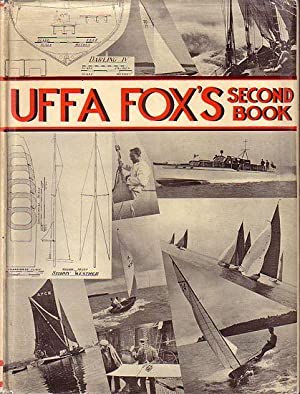
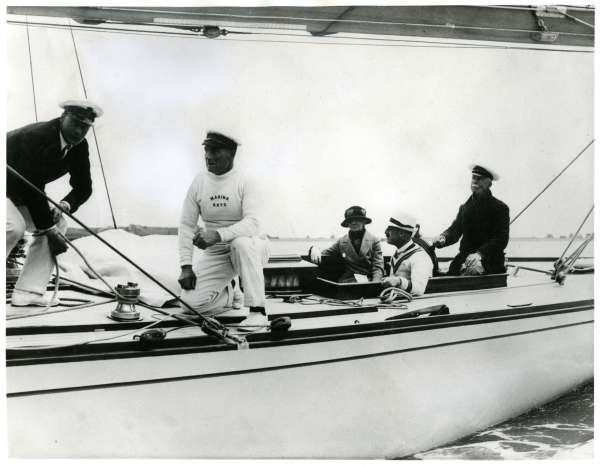
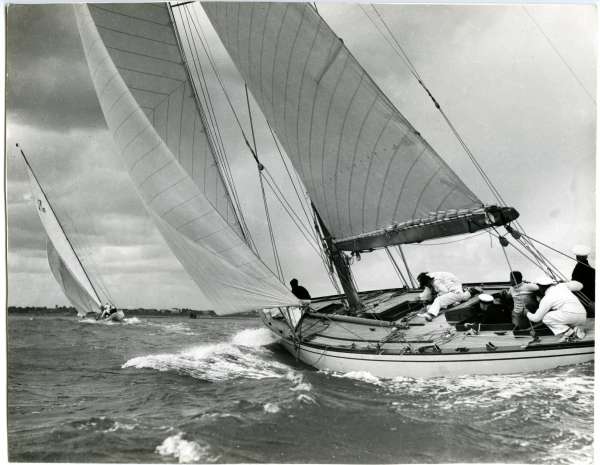
Marina was only surpassed by JENETTA, designed in 1939 by the Master himself, Alfred Mylne. JENETTA is not only the longest 12 metre ever built but was also one of the fastest, the only one capable of beating Vim in 1939. However, Burton did not race her as much due to the outbreak of the War and of course his own advancing years. Building JENETTA was a project, based upon Sir Burton’s many experiences and Mr. Mylne’s best considerations. The corresponding letters between the two highly qualified gentlemen prove a keen eye for details in their initial designing process -Nothing was left for chance, every part was analyzed, perfected, and discussed meticulously.
Sir William Parker Burton, president of the Yacht Racing Association, died at Burstall, near Ipswich in 1942, at the age of 78.
Sir William Burton, who succeeded the Duke of Windsor, was;
- President of the Y.R.A.,
- Captain of Sir Thomas Lipton’s Shamrock IV. in 1920, when she came very near to winning America’s Cup.
- He had the unusual honor of being knighted aboard the Royal yacht in 1921 by King George V.
For many years he was a leader among Mersey yachtsmen and an expert canoeist.
He was one of the first yachtsmen to pass the Board of Trade examination. He was a leader in the movement which ended in the foundation of the Yacht Racing Association and was for years an active member of the Council. At all times he has labored to stimulate an interest in yacht racing and the development of a healthy type of boat.
Besides his yachting interests, he was a keen hunting man. He was Master of Staghounds, 1907-1914, and Joint Master of Essex and Suffolk Foxhounds from 1912 till 1928.
Lady Burton, who died in November 1996, was described as “ the greatest yachtswoman.”
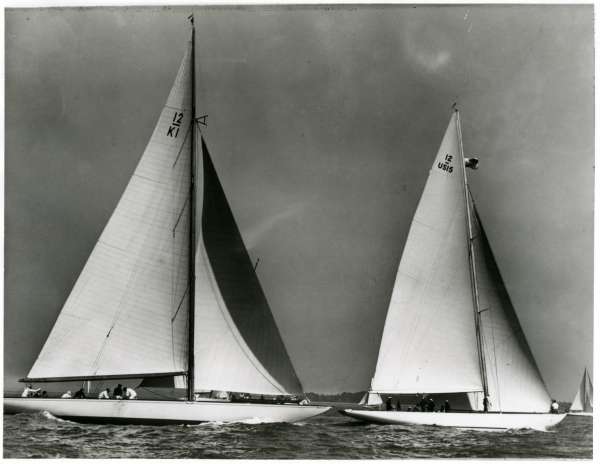
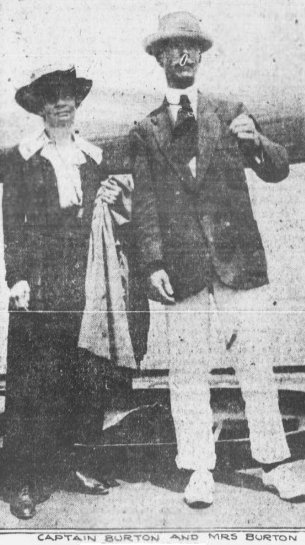
Sir William Burton,
-the First amateur
Sir William Burton made his fortune in the sugar trade. Sugar and tea have a natural affinity and so he first became a business partner, and later a friend of Sir Thomas Lipton with whom he shared the passion for yacht racing.
Mr. Burton became the skipper and helmsman of Lipton’s SHAMROCK IV in the close challenge for America’s Cup in 1920.
He had all at his charge, as with him he had his own skipper, Capt. Albert Turner, a crew of his countrymen who had all sailed with him on the famous British racing yacht Octavia. Burton also brought his wife, a capable sailor who would serve him as a member of the so-called afterguard that would offer help with key decisions.
The New York Tribune, Tuesday, July 20th, 1920 wrote:
Captain William P. Burton, the amateur skipper of Shamrock, whose seamanship was derided by all the experts after Saturday’s race, sailed the British sloop to victory yesterday. His wife sat beside him in the cockpit and shared the triumph of her husband as a member of the crew. Sir Thomas Lipton, the owner of Shamrock, whose heart’s desire is the winning of the cup, gambled upon the ability of his skipper in spite of the fact that the experts to a man had challenged his competency, and Lipton’s luck won. Or was it Lipton’s shrewd judgment of men?
Link to the full article, provided by: Library of Congress, Washington, DC; New-York tribune.
William Burton became the first amateur to ever sail a challenger for America’s Cup. The thirteenth challenge was a battle between amateurs for the first time in yachting history, and a battle between men very similar in their methods and thoroughness.
Years before it was originally agreed that only a professional could sail such yachts as cup defenders, but the crowd had to admit the skills that the amateurs had developed were extended to such a degree, that there were only a few professionals who could cope with them.
According to those who knew him, Burton had a reputation for making NO mistakes.
He was thinking quickly and then acted promptly, and never got rattled. However, after the withdraw of RESOLUTE in the first race and the postponement of the second match due to lack of wind, a number of American journalists were unleashing against Mr. Burton, questioning the qualities of a “more qualified person”. The English skipper was gracefully shutting the mouths of his critics -by winning easily the second race, the very next day.
The race in short,
During the first race, Shamrock IV crossed the line ahead of the start, having to circle back around and provide an early lead to Resolute. However, later in the race, the shackle holding Resolute’s mainsail broke, forcing the boat to complete the race only under jib. This provided Lipton with his first America’s Cup victory, although he refused to celebrate this win.
The second race was without incidents and Shamrock IV won by a corrected two minutes ahead of Resolute.
The following three races were under lighter conditions, which disadvantaged Shamrock IV and allowed Resolute to win. Police estimated that over 75,000 people watched the final race.
Though Shamrock IV was narrowly beaten by the American defender, Resolute, by 3 races to 2 nevertheless, the episode was Lipton’s best ever challenge.

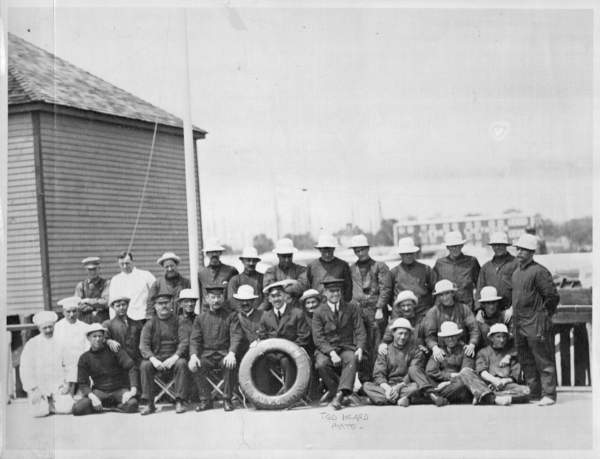
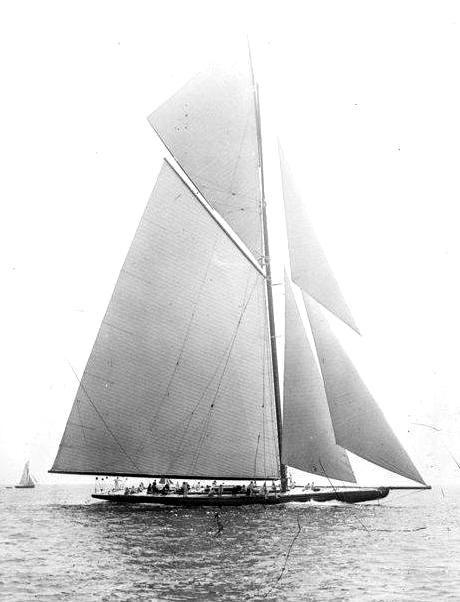
Historical Reference links:
- British Pathé, historical collection
- Herreshoff; The Curator’s Log: The 100th Aniversary of RESOLUTE’s Defense and the 13th Challenge (Part II)
- SKIPPERS ARE BIG FACTORS IN RACE; C.F. Adams, Amateur, in Command on Resolute and W.P. Burton Shamrock’s Corinthian.
- SHAMROCK SKIPPER DISCUSSES DEFEAT; Admits Resolute Was Better Boat but Regrets Weather Conditions–No Error of Judgment.
- Mersea Museum, Mersea island, Essex (UK)
- National Portrait Gallery, the person collections
- Library of Congress, Washington, DC

